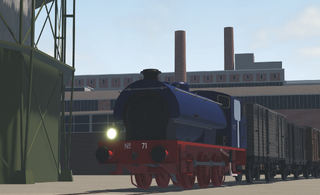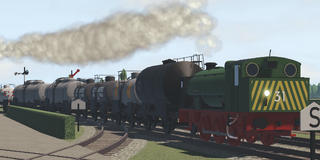| NS 8800 | |
|---|---|
| by Synchorus | |
| Price | ƒ50.000 |
| Level | 18 |
| Statistics | |
| Type | Shunter |
| Top Speed | 50 km/h |
| Weight | 49 tons |
| Capacity | 400 tons |
| Length | 9,2 meters |
The NS 8800 was a class of 27 British-built Dutch Ct (0-6-0T) shunting locomotives. The type is among the most-preserved steam locomotive types in the world.
Variants
The NS 8800 is available in 5 liveries. With the in-game order, these are: Standard (Nederlandsche Spoorwegen green); War Department green; Hoogovens green; Oranje-Nassau mines black; Staatsmijnen blue and Lining (Nederlandsche Spoorwegen green with black lining).
The War Department green livery is only available if the War Department gamepass is owned.
Historical details
The design
Pre-war
Just before the outbreak of WWII, the Great Britain created the Ministry of Supply, which included the Directorate of Transport and Materials. The DTM was led by a head engineer of the London, Midland & Scottish Railway (LMS). The Ministry of Supply ordered 240 locomotives to help with the growing need for traction in the UK. These machines would be, minus a few unimportant details, equal to the LMS 8F, a type of locomotive that had been in service since 1935. The first one was produced by the North British Locomotive Company and delivered in late May of 1940. A total of 204 1'D locomotives were build for the War Department, of which many would later be shipped to the Middle East.
Mid-war
The designs of the 8F were too time-consuming and heavy on strategic resources to continue the production. An alternative design, using less time and resources, resulted in the Austerity 1'D, 1'E and C locomotives, some of which would later become the NS 4300, NS 5000 & NS 8800 series respectively. The C locomotives were the third to be designed. They were an upgraded and simplified version of Hunslet Engine Co. Ltd.'s standard type 18. The Ministry of Supply saw to it that these tank engines stayed in production until 1953. By then, 391 had been produced specifically for the MoS with another 93 being produced for the industries of the UK.
Early 1944, these 'austerities' were shipped to Europe. All three types were leased to various industries in Belgium, France, Germany and the Netherlands. Even the US army used these machines at large, albeit due to a lack of US locomotives in their sectors.
The NS locomotives
The years of war
15 of these machines were leased to the Dutch railways in October of 1944. They were used in the liberated Southside of the Netherlands at the depots Roosendaal, Nijmegen and Maastricht. Four of them were taken back by the War Department in June, 1945, though another ten were free to be rented in August that year. The series was completed by another six that were rented November of the same year. The 27 were sold to NS in 1947.
Post-war
The locomotives were favoured by personnel. They made name for themselves by being able to handle practically any train thrown at them. Even the shunting of heavy coal trains was no problem for these machines. Many of the drivers and stokers from Fijenoord depot preferred using the 8800s to go to Waalhaven or Pernis instead of the diesel locomotives of the series 500 and 600. The slightly larger driving wheels made the locomotives suitable for short trains between the different shunting yards of Rotterdam. The 8800s did not have an air brake; it required a great level of skill to pull a train with an 8800 and mostly to get it to stop in time.
The 125 locomotives of the series 500, 600 and 700 made the 8800s redundant. The last NS austerity Ct was withdrawn in 1955.
The NS 8811 & 8826 were sold to the mine Julia in 1953, where they worked as 'Julia IV' and 'Julia V'. In 1962, after the mine Julia and Laura became the property of the company Laura & Vereeniging, they were renumbered to LV 13 and 14. In 1954, NS sold the 8812 to the same mine, followed by 8807 & 8815 in 1957. They were renumbered to LV 15, 17 and 16.
The Dutch industry locomotives
Laura & Vereeniging bought WD 75024 in 1945 and used it as LV 12 until 1966. Additionally, the NS 8811 & 8826 were sold to the mine Julia in 1953, where they worked as 'Julia IV' and 'Julia V'. In 1962, after the mine Julia and Laura became the property of the company Laura & Vereeniging, they were renumbered to LV 13 and 14. In 1954, NS sold the 8812 to the same mine, followed by 8807 & 8815 in 1957. They were renumbered to LV 15, 17 and 16.
The Staatsmijnen (State mines) rented three of the tank engines as SM 71-73 in 1945. WD 75001, 75002 & 75198 returned to the War Department a year later. They would buy eight locomotives in 1947. The WD 75007, 75074, 75075, 75009, 71496, 75011, 75014 & 75136 worked, in that order, as SM 65-69, SM 71-73 and would be withdrawn between 1957-1959.
The Koninklijke Nederlandse Hoogovens en Staalfabrieken (KNHS, or simply 'Hoogovens') bought the WD 71489, 71491, 75197. These worked as the numbers 31-33 until their withdrawals between 1958-1960.
The Oranje-Nassau mines bought the WD 75198, which was rented by the Staatsmijnen as SM 73 earlier, in 1947 and would use it as ON 28.
NS 8817 was sold in 1957, to the Verenigde Coöperatieve Suikermaatschappij (United Cooperative Suger Company) in Roosendaal, where she worked until the end of the '60s.
Heritage
NS 8817
Ex-NS 8817, after working at the Verenigde Coöperatieve Suikermaatschappij in Roosendaal, was gifted to the heritage railway Stoomtrein Goes-Borsele (SGB). Sadly, the SGB did not have the money to transport the locomotive, which could not be done by rail due to some loose tyres, so it was ultimately scrapped in 1979.
NS 8811, 8812, 8815 & 8826
These are only three of the six austerity Ct's Laura & Vereeniging had, the others were scrapped. The 8812 and 8826 were sold to metal trader Van Raak in Tilburg in 1975. Van Raak rented both to the heritage railway Stichting Stoomtreinmaatschappij Tilburg-Turnhout (SSTT), which used it for a couple seasons until the boiler was rejected during an inspection and the bankruptcy of the SSTT. Van Raak then used it as a monument on their terrain until a deal was struck with another heritage railway in 1998. The Zuid-Limburgse Stoomtrein Maatschappij (ZLSM) has owned 8826 ever since, with plans of making it operational again. Currently, however, different parts of the locomotive are spread across various places along the line.

NS 8812 was never used by the SSTT, but used to supply parts for the 8826. Its boiler, with the frame of NS 8815, was sold to the Ribble Steam Railway in 1988. In the UK, she was cosmetically restored for presentation at Southport, but moved to their workshop at Preston on 16th April, 1999. The locomotive was overhauled at Preston, where the RSR managed to return her to operational order. She was given the name 'Walkden', after the location of a dumpsite of parts which were used to restore her. The locomotive had running in trials during August 2008 and returned to service later that year. Walkden was rented out to other heritage railways in the UK and returned home around 2014 for a 10-year-overhaul. It is hoped that she will run again in 2024.
NS 8811 was found on accident in a to-be demolished shed in 1980. It was planned to be scrapped but saved at the last moment by Stoom Stichting Nederland (SSN), who obtained it in 1981. It has been in their collection ever since and, although operational, it is rarely used as the SSN specialises in mainline operations, for which the little tank engine is too slow.
Technical details
The NS 8800s were originally equipped with: the driver's place on the right; steam-powered brake for the locomotive; sanders that worked two axles (which depended on the direction of travel); two injectors and a condense lubricant pot for the cylinders.
The 8800s were not equipped with an overheater; the often and irregular steaming up of the locomotive did not justify one. To add onto that, a superheater in combination with an unmodified regulator could result in slow responses, which would mean less efficient shunting. The regulator on the 8800s was a simple pulling lever.
NS replaced a part of the back of the water tanks on a few locomotives with lids in the same shape to allow easier access to the washing hatches of the firebox. Without those lids, the whole water tank had to be removed to access those hatches. The machines with lids had 0,3 m³ less capacity.
NS would also replace the lubricant pots with mechanical lubricators.
The firebox, much like those of the NS 4300s, lacked a movable grate. Cleaning the ash tray had to be done outside, behind the locomotive.
Trivia
- The NS 8800 is a mid level steam shunter, and a counterpart to the USATC S100.
- The NS 8800 was the first shunter to receive the simple internal valve gear.
- The NS 8800 was the first locomotive to receive the new sound system, rather than using individual chuff audios at any speed, which was how it was originally.
- The NS 8800 has 6 liveries, which is the most liveries for any locomotive.
- The NS 500, 600 & 700 comes close in second with 5 liveries.
- In version 0.7.6, the NS 8800 received a temporary snowplough livery for the winter season of 2023. The plow was only available on the 'Striped' livery.
- The NS 8800 has been available since the game's launch in NS Green and WD Green, version 0.1.
- In version 0.4.28 the WD livery received period correct 'War Lamps', which reduced unnecessary illumination, to reduce attention at night.
- The Hoogovens, Oranje-Nassau, Staatsmijnen and NS Green with lining liveries were added in version 0.5.36.
Gallery
-
Staatsmijnen 71 shunts in the Dokmuiden harbour.
-
Hoogovens 31 pulls a couple chemical wagons.








